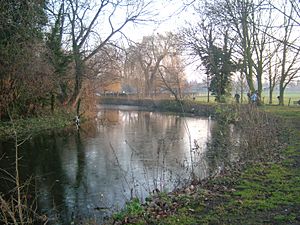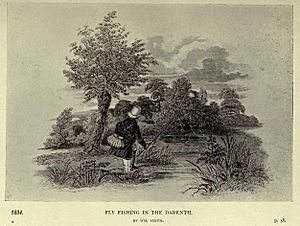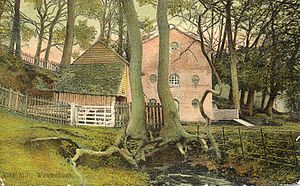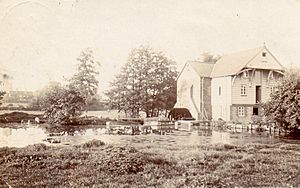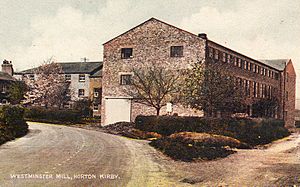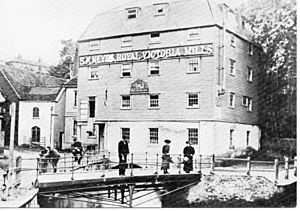River Darent facts for kids
Quick facts for kids River Darent |
|
|---|---|
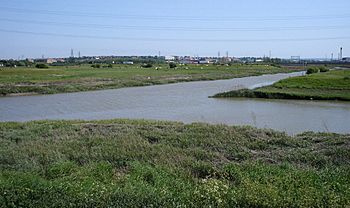
Confluence of Darent (left) and Cray rivers, viewed from Crayford Marshes, towards Temple Hill.
|
|
| Physical characteristics | |
| Main source | Hills south of Westerham TQ 450 519 51°14′53″N 0°04′26″E / 51.247917°N 0.073981°E |
| River mouth | River Thames TQ 541 780 51°28′48″N 0°13′12″E / 51.479887°N 0.220133°E |
| Length | 20 miles (32 km) |

The Darent is a river in Kent, England. It's a branch of the famous River Thames. Near Crayford, it meets another river, the River Cray. The name 'Darent' means "clear water." This makes sense because the river flows over chalk, and its springs come from chalk. The pure water was very important for making paper and medicines in the area a long time ago.
The area called Darenth Parish, where the river flows, gets its name from an old Celtic phrase. It means "stream where oak-trees grow." A famous artist named Samuel Palmer painted the beautiful landscapes of the Darent Valley in the 1800s.
The Darent starts from springs in the greensand hills south of Westerham in Kent. It also gets water from below Limpsfield Chart in Surrey. The river flows for about 21 miles (34 km). It goes east, then north, passing through towns and villages like Otford and Shoreham. You can see Lullingstone Castle and the ruins of a Roman villa along its path. It then flows through Eynsford, Farningham, Horton Kirby, South Darenth, Sutton-at-Hone, and Darenth. Finally, it reaches Dartford. From there, it travels two more miles as a tidal river before joining the Thames.
North of Dartford, the Darent is affected by the tides. Just before it reaches the Thames, it meets the River Cray at Dartford & Crayford Marshes. Here, the rivers form the border between Greater London and Kent. The Darent then flows into a part of the Thames called "Long Reach."
Kent County Council has created a walking path along the Darent. It's about 19 miles (31 km) long and is called the Darent Valley Path. It goes from the Greensand Hills near Sevenoaks all the way to the Thames. Many people use this path for walking, jogging, cycling, and exploring. A group of local people called the "Friends of Dartford and Crayford Creeks" are working to improve the tidal part of the river. They are also forming a trust to help protect this important public area.
Contents
- Dartford and Crayford Creek
- Boats in the Creek
- Dartford Creek Tidal Flood Barrier
- The Roman Connection
- River's Past and Present
- Modern River Challenges
- Watermills of the Darent
- Westerham (Elm View) Mill
- Darenth (Tower Wood) Mill
- Squerryes (Spring Shaw) Mill, Westerham
- Valence Pump, Brasted
- Brasted Mill
- Sundridge Mill
- Chipstead Mill, Chevening
- Longford Mill, Dunton Green
- Otford Mill
- Upper Mill, Shoreham
- Lower (Shoreham Paper) Mill, Shoreham
- Wood Mill, Eynsford
- Old Mill, Eynsford
- Eynsford Paper Mill
- Farningham Mill
- Franks Generating Station, Horton Kirby
- Westminster Mill, Horton Kirby
- Horton Kirby Paper Mill
- Frog Lane Mill, Sutton at Hone
- South Darenth Mill
- Darenth Paper Mill
- Sutton (Old, Sutton at Hone, Darenth Corn, Little Darenth) Mill
- Hawley Mills, Sutton at Hone
- Dartford Powder Mills
- Lower Paper Mill, Dartford
- Victoria Mills, Dartford
- Colyers (Orchard's, Bridge, Acacia Hall) Mill, Dartford
- Silk Printing Works, Dartford
- Phoenix Mill, Dartford
- Tributaries and Their Mills
- Fords on the Darent
Dartford and Crayford Creek
The tidal part of the Darent, known as Dartford and Crayford Creek, is being cleaned up by volunteers. These volunteers are part of the "Friends of Dartford and Crayford Creek." Their goal is to make it easier for boats like narrowboats and leisure cruisers to travel up the creek. They want boats to be able to stay overnight or for a longer time.
Over the years, a lot of mud built up in the creek, especially after 1986 when it wasn't used much. Volunteers have been working hard to clear away dangerous debris from the riverbed. This makes it safer for all types of boats to pass, even when the water is low. They have also removed trees and cleared rubbish from the banks. This work is helping to bring the creek back to life.
Boats in the Creek
In April 2015, a narrowboat named Pentargon visited Dartford Creek. This was a big event because it was the first time in over forty years that a registered boat had stayed there overnight. The crew wanted to see if it was possible for canal boats and other boats from the River Medway or the Thames to visit the creek.
The Pentargon returned in June 2015 and stayed until October. During this time, the crew learned a lot about the tides and how to navigate the creek. This information is very helpful for future boat visits. The boat was able to rest on a mudbank near the lock, which was only reachable during spring tides (when the tides are highest). The visit proved that both Dartford and Crayford creeks could be used by different types of boats.
Volunteers worked hard to prepare the quayside for the Pentargon's first arrival. They cleared away years of mud and neglect to create a clean place for the boat to tie up. This work continued in 2016. In February 2016, engineers also cleared trees at the top of Crayford Creek. This opened up the "End of Navigation" for boats. Crayford Creek is seen as a good place for boats with masts, as they cannot go under the Bob Dunn Bridge to reach Dartford.
Historical records show that both creeks have been used for trade since before Roman times. Trade was very busy during the Industrial Revolution. In 1835, nearly 60,000 long tons of goods were moved in or out of the creek. This supported a lot of industry. A ship canal was planned in the early 1800s but didn't happen. However, in 1839, a new plan was approved by Act of Parliament. This led to the creek being straightened, deepened, and shortened.
Dartford Creek Tidal Flood Barrier
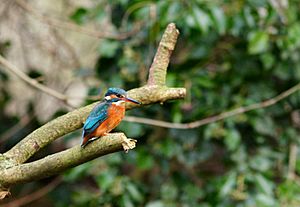
Near where Dartford Creek meets the Thames, there is a special barrier. It's called the Dartford Creek Tidal Flood Barrier. It has two huge gates, each weighing 160 tons. These gates can be lowered if the sea level rises too high and threatens to flood the land. The Environment Agency manages this important barrier.
The Roman Connection
Dartford was a very important place in Roman times. Its name, "Dartford," comes from "Darent-ford," meaning a place where you could cross the River Darent. This crossing point existed even before the Romans arrived. Dartford was a busy town during the Roman period, from about AD 50 to AD 450. Later, around 1235, a ferry was set up. The first bridge was built during the time of King Henry IV (1399–1413) and lasted until the 1700s.
River's Past and Present
Today, the River Darent is much smaller than it used to be. It's more like a stream, even though it flows through a wide valley. In the past, the "proto-Darent" was a much bigger river. However, the River Medway has "captured" a lot of the Darent's original water sources. This happened because the Medway eroded the soft chalk and clays of the North Downs and Western Weald.
Modern River Challenges
In 1989, people noticed that almost no water was flowing through Dartford. The River Darent was even called the 'lowest flowing' river in the country. This caused a lot of harm to the wildlife. The problem was that too much water was being taken from the river to supply nearby towns and even parts of London.
Since 1989, a lot of work has been done to fix this. The Environment Agency has closed down several boreholes (deep wells that draw water from underground). This has helped the river recover. In 2004, a sculpture was unveiled to celebrate the renewed life of the river and the wildlife that had been saved.
Watermills of the Darent
The River Darent was a very important source of power for many watermills along its banks. These mills were used for different purposes, like grinding corn or making paper. Here are some of the notable mills:
Westerham (Elm View) Mill
This was a corn mill. It had a large waterwheel that was later adapted to pump water for Westerham. The mill stopped working in 1936, and the building was later demolished.
Darenth (Tower Wood) Mill
This corn mill had an outside waterwheel and two pairs of millstones. It was used until the start of the First World War and was taken down in the 1930s.
Squerryes (Spring Shaw) Mill, Westerham
This was a small corn mill with a waterwheel. It was marked as disused on maps by 1895 and was demolished by 1955.
Valence Pump, Brasted
This was a water-powered pump that used a large waterwheel to drive two pumps. It was built in 1858 and was still there in 1980.
Brasted Mill
This corn mill is now a house. It had a large waterwheel. The mill stopped working in the 1920s, and its machinery was removed around 1934.
Sundridge Mill
This was a paper mill that even made paper for the Bank of England. It closed in 1901, and the buildings were later used as a laundry before being demolished.
Chipstead Mill, Chevening
This four-storey mill worked until after the Second World War. It used a waterwheel and later a gas engine for power.
Longford Mill, Dunton Green
This corn mill was rebuilt in 1859. It used a waterwheel to drive three pairs of millstones. It stopped working in 1947, and the building was demolished in 1987.
Otford Mill
There has been a watermill in Otford since 1541. The last mill on this site was a corn mill with two waterwheels. It later became a saw mill and burned down in 1924.
Upper Mill, Shoreham
This corn mill originally used a waterwheel, which was later replaced by a water turbine. The mill building was turned into a house in 1971.
Lower (Shoreham Paper) Mill, Shoreham
This site used to have a fulling mill (for treating cloth) and later became a paper mill. It was demolished in 1936.
Wood Mill, Eynsford
This mill, located downstream of Eynsford Bridge, was a water-powered saw mill built around 1853.
Old Mill, Eynsford
This corn mill is right by the ford in Eynsford. It had a waterwheel and worked until 1911. The building is still standing today as a house.
Eynsford Paper Mill
This paper mill was started in 1648 by Huguenot refugees. It had a large waterwheel. The mill suffered two fires but was rebuilt. It worked until 1952 and has since been demolished.
Farningham Mill
A mill has been on this site since the Domesday Book (a very old survey from 1086). The current building was built around 1780 and was a corn mill. It later used a water turbine to power a saw mill and stopped working for trade in 1900.
Franks Generating Station, Horton Kirby
This station, built in the late 1800s, used a turbine to generate electricity for Franks Hall.
Westminster Mill, Horton Kirby
This corn mill was powered by a waterwheel, which was later replaced by a turbine to generate electricity. The mill burned down in 1908 after being struck by lightning. It was rebuilt as a factory and later demolished for housing.
Horton Kirby Paper Mill
This mill is located under a railway viaduct. It was rebuilt as a paper mill in 1820. Paper from this mill was used for famous newspapers like The Sphere and The Tatler. It has a very tall chimney, which is a listed building. The mill closed in 2003.
Frog Lane Mill, Sutton at Hone
This 19th-century corn mill had a cast iron waterwheel. It stopped working by 1914, and most of the building was demolished in 1936.
South Darenth Mill
This brick mill replaced an earlier one that burned down in 1879. It had a waterwheel and a steam engine. It stopped milling in 1905 and was badly damaged in the Great Storm of 1987.
Darenth Paper Mill
This paper mill worked until 1931. It had a large cast iron waterwheel with wooden floats.
Sutton (Old, Sutton at Hone, Darenth Corn, Little Darenth) Mill
This corn mill was built in the early 1800s. It later had a steam engine and a tall chimney. A bomb hit the mill during the First World War, putting it out of action. The mill was demolished in 1928.
Hawley Mills, Sutton at Hone
This site has been home to mills since the Domesday Book. In 1588, John Spilman turned a corn mill into a paper mill and even got a special permission from the King to be the only one making paper. He employed 600 people, mostly from Germany. Later, the mills were used to make gunpowder and had several explosions that sadly killed many people. By 1840, it was a paper mill again. Another mill here was used for making nails, which was the first of its kind in England.
Dartford Powder Mills
These mills made gunpowder and were in operation from around 1730 until the 20th century.
Lower Paper Mill, Dartford
This mill was built in the mid-1600s and closed in 1790. It was later used for rolling zinc and printing on silk.
Victoria Mills, Dartford
This site had mills since the 15th century, including a fulling mill and a wire mill for polishing armor. In the early 1800s, there were an oil mill, a mustard mill, and a corn mill. The corn mill had a large waterwheel and its miller was even appointed to King George IV.
Colyers (Orchard's, Bridge, Acacia Hall) Mill, Dartford
This mill has a long history, dating back to 1217 when King John granted it. It was a corn mill that later became a social club. It burned down in 1962.
Silk Printing Works, Dartford
There was a silk printing works in Dartford that was powered by a waterwheel. The waterwheel was removed in 1986.
Phoenix Mill, Dartford
This was the mill furthest down the Darent. It started as a mill for splitting iron into rods and nails. Later, a seven-storey cotton mill was built, but it burned down. A smaller building, the Phoenix Mill, was built in 1797. It became a paper mill and closed in 1889.
Tributaries and Their Mills
Several smaller streams flow into the River Darent. These tributaries also powered a number of watermills.
Stream at Brasted
Mill Farm Mill, Brasted
This mill may have been built in 1705. It stopped working around 1858, and the building was later converted into a garage.
Stream at Chevening
Whitley (Dibden) Mill, Chevening
This mill was deep in the woods west of Sevenoaks. It was in use until the mid-1800s but stopped working by 1900 and was in ruins by the 1920s.
Stream at Ightham
Ightham Mill
A stream near St. Cleres is believed to have powered a watermill, possibly the one at Ightham recorded in 1322.
Kemsing Mill
This mill was on the same tributary as Ightham Mill. Kemsing is thought to be the site of a Roman watermill at Springhead, which was found in 1949.
Greatness Stream
Greatness Mill, Sevenoaks
This is an old mill site, mentioned in 1381. It was a corn mill that later had roller milling equipment. In 1927, it was still powered by water, with help from a gas engine.
Greatness Silk Mill, Sevenoaks
This mill was built in 1761 for making silk. It employed 100 people at one point. It closed down around 1828.
Guzzlebrook
Childs Bridge Mill, Kemsing
This was a long-lost mill site, thought to be a corn mill. It had a large mill pond.
Longlodge Mill, Otford
This might have been one of the eight mills mentioned in the Domesday Book for Otford. It was abandoned a long time ago.
Stream at Bradbourne
Bradbourne Mill, Sevenoaks
This corn mill was granted by Henry VIII in 1545. It also had a "Sythe Mill" (possibly for scythes or saws).
Cranpit Stream
Hall's Engineering Works, Dartford
A Millwright named John Hall built a cast iron waterwheel here to power some of the machinery at his workshops.
Fords on the Darent
There were several places where people could cross the River Darent by ford (a shallow part of a river).
Shoreham
- There was a ford next to the bridge in the village.
Eynsford
- Eynsford is famous for its ford, which is still used today, right by the old packhorse bridge.
Farningham
- There used to be a ford at Farningham, but now there is a bridge instead.
Dartford
- In Roman times, there was a ford in Dartford. The town's name, Dartford, means "Darent-ford." This ford was still in use in 1840.


